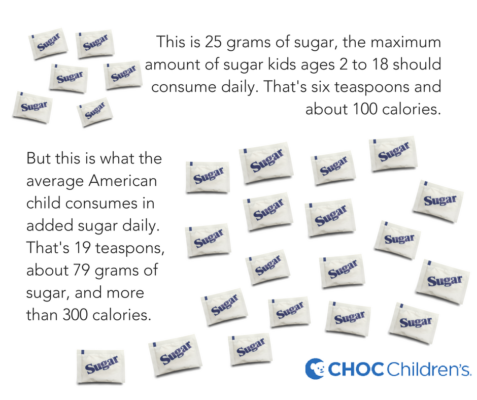By Kristen Miller, registered dietitian at CHOC
New recommendations from the American Heart Association state that children ages two to 18 should have less than 25 grams of added sugars per day and drink no more than one 8-ounce sugar-sweetened beverage per week. But what does 25 grams of added sugars look like?

Know the Difference: Natural vs. Added sugars
Naturally occurring sugars such as those found in whole pieces of fruit, some vegetables (i.e. corn), or plain dairy products are not added sugars and play an important part of a healthy, balanced diet. So keep eating those apples, berries, peaches and oranges! Whole pieces of fruit provide fiber that helps to evenly distribute blood sugars compared to the “sugar high” (quick spike in blood sugar) that can occur when drinking sweetened beverages or eating candy.
Added sugars include any syrups or sweeteners added to a food and are most commonly found in processed, packaged foods, resulting in an increase in calories without contributing essential nutrients. Consuming large amounts of added sugars may make it difficult for children to meet their nutrient needs while staying within calorie limits. Consuming large amounts of added sugars put children at higher risk for obesity, high blood pressure, high cholesterol, cardiovascular disease, fatty liver disease, diabetes and dental cavities.
Most Common Sources of Sugar
In a child’s diet, the most common sources of added sugars are soda, fruit-flavored drinks, sports drinks, and desserts. Most sodas, energy drinks, sports drinks, and flavored milks have 20-35 grams of sugar per serving!
With Halloween approaching, make sure to be mindful of all of the added sugars in candy! A mere 10 pieces of candy corn has a whopping 16 grams of added sugars! Some other common candies and their hidden added sugars include:
- 5 chocolate kisses = 13 grams of added sugar
- 10 gummy bears = 13 grams of added sugar
- 2 classic sized peanut butter cups = 21 grams of added sugar
- 2 vines of licorice = 16 grams of added sugar
According to the 2012 US Census Bureau, the average American consumes 24 pounds of candy in a year- That’s a lot of added sugars!
Reading Food Labels
Added sugars can sometimes be difficult to identify. Look for these items in the ingredient list to determine if the food has added sugars: brown sugar, corn sweetener, corn syrup, dextrose, fructose, glucose, high fructose corn syrup, honey, invert sugar, lactose, malt syrup, maltose, molasses, raw sugar, sucrose, trehalose, and turbiado sugar.
Keep your eyes out for the new food label coming out by July 2018. An ‘added sugars’ row will now be included on the label. Identifying added sugars will be much easier!
Tips for Limiting Added Sugars in the Diet
- Choose water instead of sugary beverages. If you like flavored beverages, try adding lemon, cucumber & mint, or berries to your water for an infused flavor.
- Choose club soda or seltzer water for a carbonated drink instead of a regular soda.
- Choose fruit as a dessert instead of cakes, pies, cookies, doughnuts, ice cream, or candy. The United State Department of Agriculture offers information on when certain fruits and vegetables are in season.
- Choose plain dairy products instead of flavored milk or dairy such as chocolate milk or sweetened yogurts. Add some fresh fruit to plain yogurt for natural sweetness.





